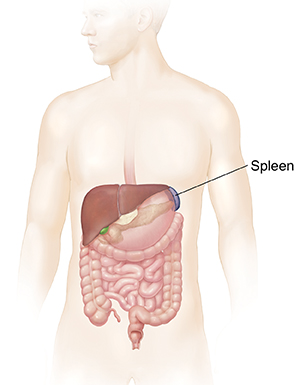Understanding a Bruised Spleen
A bruise (contusion) is a type of injury. It occurs when small blood vessels break open and leak blood into nearby tissues. The spleen is a small organ located in the upper left part of the belly (abdomen). The main role of the spleen is to filter your blood. It sits under the left ribs in front of the stomach. It can become bruised after an injury to the area.

What causes a bruised spleen?
The spleen can become bruised from:
Symptoms of a bruised spleen
You may feel pain and soreness in the upper left part of your belly. You may also feel pain in the left side of your chest, under your left ribs, or in your left shoulder. In some cases, you may have bruised skin over the injured area. The abdomen may swell. In severe cases, you may have signs of shock. These include change in alertness and low blood pressure.
Treatment of a bruised spleen
Treatment for a bruised spleen depends on how severe the injury is. Some cases may be managed without surgery. But you may still need:
-
Close monitoring in the hospital
-
Bed rest and IV (intravenous) fluids
-
Tests to check for blood loss and other injuries
-
Imaging tests such as CT scan to look at the internal organs
For a minor bruise
If the bruise is minor with no signs of blood loss, you may be discharged from the hospital after several days. Home care may involve further rest. You may also need to stop some activities until your spleen heals. You may also need follow-up care with your healthcare provider.
For a severe case
In severe cases, or if tests show blood loss or other injuries, you will likely need a procedure or surgery. These may be used to:
-
Drain excess fluids or blood from the abdomen
-
Find and stop the source of bleeding in the spleen or abdomen
-
Remove the spleen and repair other injuries as needed
Possible complications of a bruised spleen
These can include:
Call 911
Call 911 right away if you have signs of shock. These include:
-
Pale skin
-
Rapid pulse
-
Shallow breathing
-
Dizziness
-
Fainting
-
Confusion
When to call your healthcare provider
Call your healthcare provider right away if you have any of these:
-
Fever of 100.4°F (38°C) or higher, or as directed by your provider
-
Chills
-
Symptoms that don’t get better with treatment, or get worse
-
New symptoms